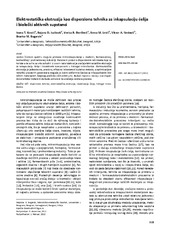Приказ основних података о документу
Electrostatic extrusion as a dispersion technique for encapsulation of cells and bioactive compounds
Elektrostatička ekstruzija kao disperziona tehnika za inkapsulaciju ćelija i biološki aktivnih supstanci
| dc.creator | Kostić, Ivana T. | |
| dc.creator | Isailović, Bojana D. | |
| dc.creator | Djordjević, Verica B. | |
| dc.creator | Lević, Steva | |
| dc.creator | Nedović, Viktor | |
| dc.creator | Bugarski, Branko | |
| dc.date.accessioned | 2020-12-17T20:27:17Z | |
| dc.date.available | 2020-12-17T20:27:17Z | |
| dc.date.issued | 2012 | |
| dc.identifier.issn | 0367-598X | |
| dc.identifier.uri | http://aspace.agrif.bg.ac.rs/handle/123456789/2916 | |
| dc.description.abstract | Significant development of cells and bioactive compound encapsulation technologies is taking place due to an exceptional possibility of their application in various scientific disciplines, including biomedicine, pharmacy, cosmetology, food and agricultural sciences, beverage production, industrial waste treatment. Despite the broad application of microencapsulation, the literature reviews on dispersion techniques for microcapsule/microbead production, their advantages, restrictions and drawbacks are scarce. The purpose of this paper is to assess the possibilities of electrostatic extrusion for encapsulation of biological material, including living cells in hydrogel microbeads. The paper presents an overview of the mechanisms of droplet formation and controlling experimental parameters for producing microbeads by means of electrostatic extrusion. Electrostatic droplet formation utilizes a special type of physical process taking advantage of electrostatic effects occurring in flowing conductive liquids after introduction of an electric field. When an electrostatic field is applied to the metal needle and an electric charge is induced in the liquid flowing out of the needle, the size of droplet detaching from the needle tip decreases as a function of applied electrostatic field. It has been shown that few parameters affect microbead size: applied voltage, electrode geometry, needle size, polarity arrangement and polymer concentration. The electrostatic droplet formation is one of the most precise methods, which enables one to produce spherical and uniform particles ranging from 100 up to 1000 μm. Most of the authors report that the encapsulated compounds (drugs, enzymes and living cells) remain unaltered after electrostatic extrusion. This technique seems to be particularly promising in biotechnology, pharmaceutical and cosmetics industries, where a low-temperature process, preserving heat-sensitive material is a prerequisite. Future efforts in developing of electrostatic extrusion should be directed towards adequately scaling-up for commercial purpose. | en |
| dc.description.abstract | Uprkos širokom spektru moguće primene mikroinkapsulacije u medicini, farmaceutskoj, kozmetičkoj i prehrambenoj industriji, literaturni podaci o disperzionim tehnikama koje se koriste u te svrhe su vrlo oskudni. U ovom radu istaknut je značaj elektrostatičke ekstruzije za inkapsulaciju ćelija i bioaktivnih komponenti u hidrogel mikročestice. Elektrostatička ekstruzija je jednostavna, precizna, efikasna i ekonomski isplativa metoda, a optimizacijom nekoliko procesnih parametara moguće je dobiti uniformne čestice sa inkapsuliranim biološkim materijalom željenog prečnika (100-1000 μm). Budući napori u razvoju ove disperzione tehnike trebalo bi da budu usmereni ka uvećanju razmera procesa. | sr |
| dc.publisher | Savez hemijskih inženjera, Beograd | |
| dc.relation | info:eu-repo/grantAgreement/MESTD/Integrated and Interdisciplinary Research (IIR or III)/46010/RS// | |
| dc.rights | openAccess | |
| dc.rights.uri | https://creativecommons.org/licenses/by-nc-nd/4.0/ | |
| dc.source | Hemijska industrija | |
| dc.subject | dispersion techniques | en |
| dc.subject | electrostatic extrusion | en |
| dc.subject | cell and bioactivecompound encapsulation technology | en |
| dc.subject | alginate | en |
| dc.subject | microbeads | en |
| dc.subject | disperzione tehnike | sr |
| dc.subject | elektrostatička ekstruzija | sr |
| dc.subject | imobilizacija ćelija | sr |
| dc.subject | hidrogel mikročestice | sr |
| dc.title | Electrostatic extrusion as a dispersion technique for encapsulation of cells and bioactive compounds | en |
| dc.title | Elektrostatička ekstruzija kao disperziona tehnika za inkapsulaciju ćelija i biološki aktivnih supstanci | sr |
| dc.type | article | |
| dc.rights.license | BY-NC-ND | |
| dc.citation.epage | 517 | |
| dc.citation.issue | 4 | |
| dc.citation.other | 66(4): 505-517 | |
| dc.citation.rank | M23 | |
| dc.citation.spage | 505 | |
| dc.citation.volume | 66 | |
| dc.identifier.doi | 10.2298/HEMIND111209013K | |
| dc.identifier.fulltext | http://aspace.agrif.bg.ac.rs/bitstream/id/1586/2913.pdf | |
| dc.identifier.scopus | 2-s2.0-84866520758 | |
| dc.identifier.wos | 000311465200008 | |
| dc.type.version | publishedVersion |


